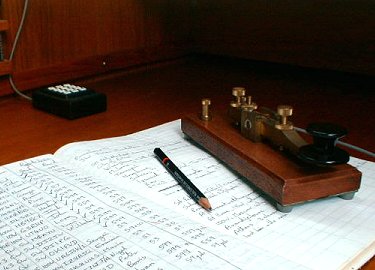

The history of radio communications is inextricably tied up with shipping and sea travel. Before radio, ships out of sight of land and each other were completely out of contact with the rest of the world. I became quite fascinated by radio as soon as I began making any trips out onto the sea. It is foolish to make even a short trip around a bay without a hand-held VHF transmitter on board. I was amazed at find myself with a transmitting licence so easily but frustrated by the limitations on a Marine Operator's (Restricted) Certificate.
 |
| The rich hues of radio's history afloat. Morse code may be arcane, archaic and difficult to learn but it can provide a very satisfying way to spend an evening. Perhaps Yahoo-Chat is more fun, but so easy... |
It took quite a bit of research to find out about the secret and almost forgotten world of Amateur Radio, but eventually I had a syllabus, a text-book and information about the City and Guilds examination that I would have to pass to get the licence. Radio Amateurs have a glorious history within that of radio in general. Most of the early experiments and developments, including television, trans-Atlantic contact and many others, were carried out by people with amateur licences.
The Amateur Radio Licence gives rights (and responsibilities!) way beyond those given by any other class of radio transmission licence. Amateurs are allowed to build, rest and calibrate their own transmitters without type approval and then transmit up to 400 watts of power on freqency bands from LF through MF, HF, VHF, UHF and way up into the microwave spectrum. Perhaps you know these better as Long Wave, Medium Wave and Short Wave Bands.
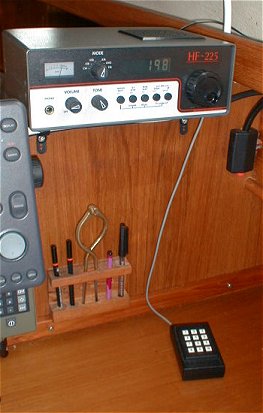 |
| This high quality receiver tunes the whole LF, MF and HF bands. It can help with navigation and weather forecasting. It entertains us almost exclusively when on passage. |
Amateurs can choose to use AM, FM or SSB transmission on these bands as well as television, graphics, computer data, morse code and there are even amateur satellites in orbit. The computer side of it all includes bulletin boards and what they call Packet Radio, which is actually a form of TCP/IP, the same technology as the internet except using radio instead of 'phone lines. Unfortunately there is no real connection allowed between this radio network and the real internet - that could seriously damage the income of the telephone companies!
I eventually tracked down the local Amateur Radio Society - after I had the licence - and spent a while trying to help them drag the hobby into the 20th century (before the 21st dawned for real!). That was fun and I was grateful for their help teaching me morse code for my full Class A licence. I was also able to teach the theory for Class B licences to a handful of new members during the Winter of 1996-97.
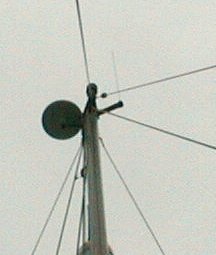 |
| At Rusalka Mist's mast top you can see the quarter-wave VHF whip, the omni-directional VHF/UHF receiver and the top insulator on the HF backstay |
Rusalka Mist is now quite well equipped as far as radio is concerned, although there is always room for more! I have a Lowe HF225 Communications Receiver screwed to the bulkhead above the chart table. This tunes from 30 kHz up to 30MHz so covering the full LF, MF and HF bands. It receives in AM, FM, CW (morse) and SSB. This usually receives using nearly the whole mast and rig as an un-tuned, non-directional antenna. Most of the time it is tuned to BBC Radio 4 on 198 kHz, Long Wave, AM, and keeps us entertained and informed, including weather forecasts, when at sea. I have an old car radio loudspeaker on a long extension lead and this sits in the cockpit or on deck (keep it away from the compass!) when needed.
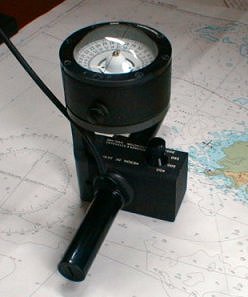 |
| I found this wonderful old Radio Direction Finding antenna in the junk piles of a second-hand shop. It works perfectly and can give a useful Line Of Position from a coastal radio beacon (NDB). My earliest trips out of sight of land relied exclusively on RDF bearings to find the landfall. |
I can swap the antenna to a lovely old 'Heron' Direction Finding Antenna, bought second-hand, and use this to get an RDF bearing on the marine and aero beacons that are still transmitting CW between about 300kHz and 400kHz. This is a useful back-up for navigation. One day I may get organised about linking this receiver with the lap-top computer and start to receive live weather faxes for the cost of some additional software. This receiver is not earthed. I have tried connecting its earth terminal to the grounding plate under the hull but it seems to make no difference to any reception band that I can detect.
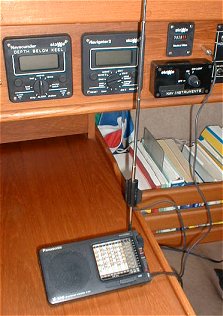 |
| The little clip which is shown in use here came with a Sony Watchman Television. It matches an aerial cable to a telescopic whip antenna very nicely. |
When we are in port it is sometimes nicer to listen to the local FM stations so we carry a Roberts RC818 multi-band receiver too. The TV antenna on the top of the mast receives both VHF and UHF so I fitted an outlet socket for this near the chart table to improve FM reception. The first portable TV I tried (a Sony Watchman) came with a very useful spring-clip which couples the 75 Ω socket to the radio's telescopic whip antenna. This Roberts receiver also includes a cassette recorder which can be useful for guaranteeing good copy of an important weather forecast. It also has a timer which can wake us up, or record an 06:00 forecast without waking us, if we can be bothered to set it.
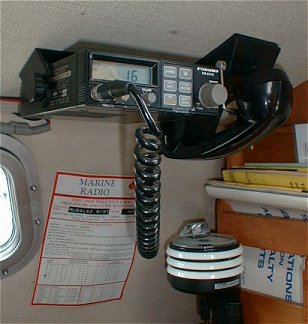 |
| This type-approved ship-to-shore radio telephone is our major means of communication from the boat. It is VHF so only has a limited range - perhaps 40 miles maximum. |
To transmit we have a 25 W Furuno ship-to-shore VHF screwed to the ceiling above the chart table. This would be our first and main recourse if ever we had to ask for assistance or call Mayday within about 40 miles of a coast station. I have used this for making 'link calls' through the main telephone network, although this is an expensive hobby! It uses a standard quarter-wave tuned mast-head whip antenna and also gives us reception of local coastal shipping forecasts. I have a hand-held amateur VHF tranceiver which is capable of transmitting 5 W on ships' emergency channels. Unlike the Furuno this is not type approved for ships' use so is strictly for emergencies and the life-raft grab-bag. When linked to the mast-head whip and it's 12 V power converter this little set can be fun in port. I contact the local amateurs and catch up on their local gossip if I'm bored.
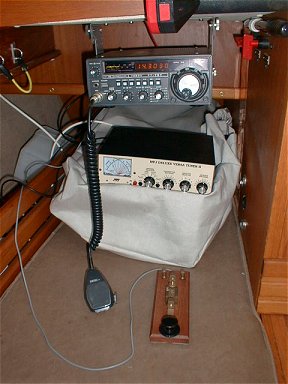 |
| It can be fiddley to set all this up, the antenna tuning unit (centre) needs careful attention every time you change frequency, but it has got virtually world-wide range. Amateur radio, like the internet, never sleeps and there's always someone to talk to if you want. |
Under the ceiling inside the quarter berth I have a lovely old 1970s amateur shortwave tranceiver. This uses the earthing plate and one of backstays, which is insulated from the rest of the rig, to transmit up to 100 W on the amateur bands from 3.5 MHz up to 28 MHz. It's a fiddle to set up but it uses SSB for speech and can be used on the amateur Maritime Mobile Nets which operate in different parts of the world. In order to get the full licence to use this I had to learn morse code at up to 12 words per minute. This took me a few months but it is very satisfying to hold a conversation in morse with someone a few thousand miles away. SSB speech is not relaxing to listen to when reception is less than perfect and switching over to the very narrow filters used for morse can actually be quite a relief, even if the arcane communication mode can then be frustrating to follow!
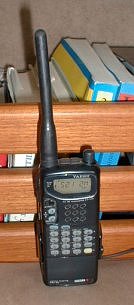 |
| Hand-held VHF transceiver gives a healthy 5 W. It can be linked to the mast-head whip, or used from the liferaft. |
My amateur call-sign is a topic in itself. In Jersey I am MJ0AQJ (that's a zero in there), when on-board in Jersey waters I am MJ0AQJ/MM (Maritime Mobile). Outside of Jersey waters I become M0AQJ/MM and if I change my 'registered station address' to one in mainland England I will be M0AQJ. Rusalka Mist's own ship's callsign is MKKZ6 and this does not change! Sometimes this is easier to spell phonetically than the full name of the boat.
I must say that the excitement that radio must have engendered in, say, the 1920s is gone now for most people. It's role in the 'techie's' life is now taken over by the internet. There is an interesting possibilty ahead: there are big possibilities for TCP/IP protocol links between computers using a mixture of radio and land-line technologies. The problem is that amateurs are very jealous of their bandwidth. When radio tranceivers are affordable up to around 47 GHz, there are acres of short-range space free up there. The other problem is that telecoms companies are very jealous of their profits. If that monopoly can be attacked it will be brilliant for all of us.